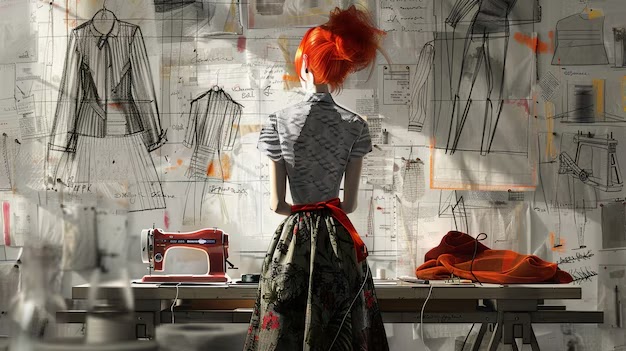“Is
Fashion art?”
The
concept of Fashion has evolved tremendously over the years as it is inherent.
Fashion is necessary for functionality, protection, as well as expression of
personal and cultural identity, however what has yet to be agreed upon, is fashion
as a medium of art. And the question boils down to one thing: “Is Fashion Art?”
What is Fashion?
”Fashion
is the creation of clothing, footwear, accessories, cosmetics and jewelry of
different cultural aesthetics and their mix and match into outfits that depicts
distinctive ways of dressing.”
In
addition, Fashion is described inn regards to populous trends and styles.
Art………
“Art is
a conscious use of skill and imagination to create something beautiful or
meaningful.”
Furthermore
it is the diverse range of cultural activity centered on works utilizing
creative or imaginative talents which are expected to evoke a worthwhile
experience, generally through an expression of emotional power, conceptual
ideas, beauty and\or technical proficiency.
Is Fashion Art?
When I was introduced to realms of haute couture by
Schiaparelli S\S 22, I thought surely this is Art living and breathing. Not art
on paper, musical sheets or in the theatres but on bodies – moving and
breathing bodies. But it seems the people who think this are limited. In the
course of researching about this subject, I came across multiple oppositions.
People believe fashion, with all that classism and snobbery could never be a
form of art – a snobbish take I might add.
Fashion doesn’t contain artistic elements\principles
In her thesis Angelique Benton, address these arguments of
artistic elements. During the “dress reformer” movement, the use of artistic
principles was furnished to create aesthetic clothing unrestrictive to the
movement of the body. The use of principles of art: movement\rhythm, balance
proportion, scale, contrast and emphasis. As well as properties as: line,
shape\form, color, texture’ pattern were utilized in the creation of these
‘artistic dresses.’ Example:
The Fortuny
gown circa 1920-1930 created by Mariano Fortuny. This gown highlights the use
of pleating to form real lines. The waist bodice is curved shape wrapped in
curved ends. The use of translucent colors and brown. The gown all together is
a loose fitting and aligns with the champ
James Charles 'Infanata' 1920-1930
A Little on the Artistic\Aesthetic Dress Movement
The Artistic dress movement is
The Artistic movement (1848-1900) founded by the Pre-Raphaelite brotherhood advocated for liberal and lax clothing over the normative Victorian corseted and tight-fitting wear of that time. This dressing aligned mostly with ‘artistic’ persons or patrons of the ‘Arts.’ This movement influenced the Aesthetic movement (early 20th century) in defiance the rebel concept of ‘Tea Gowns.”Aesthetic Dress & Tea Gowns
 |
| Tea Gowns by Liberty London c. 1879 |
PAINTINGS
AND FASHION
The interplay between and fashion and painting transcends the mere debacle of the “Fashion is Art” argument. These genres of Art has facilitated the formation of trends and influenced contemporary traditions as well as preserving, for centuries, cultures and traditions. Over the course of centuries, fashion has influenced paintings and vice-versa, keeping abreast each patrons of their respective customs.
 |
| 'The Swing' was a commission work by Jean-Honore Fragonar. The Swing referenced the Rococo Fashion in vogue in France from 1720-1770s. |
 |
Portrait of Anne of Austria by Peter Paul Rubens, 1621-25 on Dolce & Gabbana runway, Fall 2012.Art & Fashion |
.jpeg) |
| Gianni Versace and Andy Warhol collaboration in SS'91 for the 'POP' collection. Source: Pinterest |
Paintings, The Swing and Portrait of Madame X, have the effect of: conveying populous styles and trends amongst the elites or upper-echelon for the purpose of entertainment, historical recording or preservation of legacy OR pushing society beyond the boundaries of "impropriety" and sartorial limitations (as in the case of The Portrait of Madame X). The influence of Art on Fashion is, to me, a fresh of breath, the merging of two incredible genres, as shown consistently, proves Art is One.
With the inception of the 21st Century, comes, literally, the merging of Art and Fashion. Wearable Art or 'Art to wear' are art-pieces modelled in the form of jewelry or clothing. An interesting aspect of this merger is the utter lack of rules and protocols, in reality it emphasizes on excessive flamboyance and other-worldliness, all of which I find charming
 |
| Natacha Akide, AMVCA 2024, by Mohammed Abbas Styled: Medlin Boss |
 |
| Toke Makinwa, AMVCA 2024, by Vekee James |
CONCLUSION
"Fashion is not Art," they say.
Granted they're right specifically when regular street-wear and commercialization is factored in place. It is then difficult to distinguish Fashion in its artistic form from a commercial sense. However to peddle these words is to discard the years of relationship these peas share between them. So is Fashion incredibly commercialized but does that affects its artistic side? No.




Comments